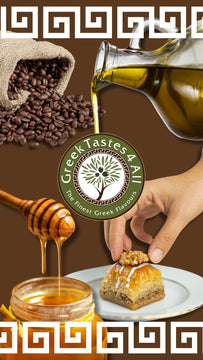Have Questions?Ask An Expert
Greek Green Pickled Peppers Traditional Pepperoncini Variety
Trustify review stars will be displayed here!
-
Nestos, Greek Green Pickled Peppers Traditional Pepperoncini Variety, Net Weight 650gr, Glass Jar:
Hand-picked only after perfectly ripening under the Greek sun, these Macedonian Green Peppers, Traditional Pepperoncini Variety are processed within hours of harvesting to ensure peak freshness and nutritional value. With a tender and pleasantly mild flavour, they offer a delightful taste without any bitter aftertaste. Their vibrant green-golden colour signifies their superior quality. To maintain their texture and taste, these whole peppers are preserved intact, not sliced or diced.
Sold in airtight glass jars, our Greek green pickled peppers are peeled and soaked in brine to preserve their delicious flavour and nutritional integrity. They are a wholesome addition to your pantry and are free from artificial colouring, preservatives, or additives.
These pickled peppers are a versatile ingredient, perfect for those who prioritize healthy eating and love the Mediterranean diet. Enjoy them whole as a tasty snack, toss them into salads for a burst of flavour, or add them to antipasto platters for a traditional touch. They also make an excellent accompaniment to various dishes, enhancing your meals with their unique, tangy taste. Embrace the essence of Mediterranean cuisine with every bite of these delectable pickled peppers.
Keep it in a cool and dry place. Keep refrigerated after opening.
-
Ingredients:
- Greek Green Peppers,
- Water,
- Wine Vinegar,
- Sea
- Salt,
- Citric Acid,
- Sodium Benzoate,
- Sodium Bisulphate.
- Pasteurized product.
Composition per 100 g. :
- Calories 18 kcal
- Fat 0 g.
- Proteins 1.2 g.
- Carbohydrates 3.5g.
- Salt 0.7g
- Sodium 90,9 mg
- Potassium 43 mg
- Iron 0,5 mg
- Calcium 14 mg
- Phosphorus 23 mg
-
Certified by ISO 22000 and HACCP Quality Assurance.
-
Nestos, Greek Green Pickled Peppers Traditional Pepperoncini Variety, Net Weight 650gr, Glass Jar:
Hand-picked only after perfectly ripening under the Greek sun, these Macedonian Green Peppers, Traditional Pepperoncini Variety are processed within hours of harvesting to ensure peak freshness and nutritional value. With a tender and pleasantly mild flavour, they offer a delightful taste without any bitter aftertaste. Their vibrant green-golden colour signifies their superior quality. To maintain their texture and taste, these whole peppers are preserved intact, not sliced or diced.
Sold in airtight glass jars, our Greek green pickled peppers are peeled and soaked in brine to preserve their delicious flavour and nutritional integrity. They are a wholesome addition to your pantry and are free from artificial colouring, preservatives, or additives.
These pickled peppers are a versatile ingredient, perfect for those who prioritize healthy eating and love the Mediterranean diet. Enjoy them whole as a tasty snack, toss them into salads for a burst of flavour, or add them to antipasto platters for a traditional touch. They also make an excellent accompaniment to various dishes, enhancing your meals with their unique, tangy taste. Embrace the essence of Mediterranean cuisine with every bite of these delectable pickled peppers.
Keep it in a cool and dry place. Keep refrigerated after opening.
-
Ingredients:
- Greek Green Peppers,
- Water,
- Wine Vinegar,
- Sea
- Salt,
- Citric Acid,
- Sodium Benzoate,
- Sodium Bisulphate.
- Pasteurized product.
Composition per 100 g. :
- Calories 18 kcal
- Fat 0 g.
- Proteins 1.2 g.
- Carbohydrates 3.5g.
- Salt 0.7g
- Sodium 90,9 mg
- Potassium 43 mg
- Iron 0,5 mg
- Calcium 14 mg
- Phosphorus 23 mg
-
Certified by ISO 22000 and HACCP Quality Assurance.
RETURNS POLICY
Lorem ipsum dolor sit amet, consectetur adipiscing elit. Morbi ut blandit risus. Donec mollis nec tellus et rutrum. Orci varius natoque penatibus et magnis dis parturient montes, nascetur ridiculus mus. Ut consequat quam a purus faucibus scelerisque. Mauris ac dui ante. Pellentesque congue porttitor tempus. Donec sodales dapibus urna sed dictum. Duis congue posuere libero, a aliquam est porta quis.
Donec ullamcorper magna enim, vitae fermentum turpis elementum quis. Interdum et malesuada fames ac ante ipsum primis in faucibus.
Curabitur vel sem mi. Proin in lobortis ipsum. Aliquam rutrum tempor ex ac rutrum. Maecenas nunc nulla, placerat at eleifend in, viverra etos sem. Nam sagittis lacus metus, dignissim blandit magna euismod eget. Suspendisse a nisl lacus. Phasellus eget augue tincidunt, sollicitudin lectus sed, convallis desto. Pellentesque vitae dui lacinia, venenatis erat sit amet, fringilla felis. Nullam maximus nisi nec mi facilisis.
SHIPPING
Lorem ipsum dolor sit amet, consectetur adipiscing elit. Morbi ut blandit risus. Donec mollis nec tellus et rutrum. Orci varius natoque penatibus et magnis dis parturient montes, nascetur ridiculus mus. Ut consequat quam a purus faucibus scelerisque. Mauris ac dui ante. Pellentesque congue porttitor tempus. Donec sodales dapibus urna sed dictum. Duis congue posuere libero, a aliquam est porta quis.
Donec ullamcorper magna enim, vitae fermentum turpis elementum quis. Interdum et malesuada fames ac ante ipsum primis in faucibus.
Curabitur vel sem mi. Proin in lobortis ipsum. Aliquam rutrum tempor ex ac rutrum. Maecenas nunc nulla, placerat at eleifend in, viverra etos sem. Nam sagittis lacus metus, dignissim blandit magna euismod eget. Suspendisse a nisl lacus. Phasellus eget augue tincidunt, sollicitudin lectus sed, convallis desto. Pellentesque vitae dui lacinia, venenatis erat sit amet, fringilla felis. Nullam maximus nisi nec mi facilisis.























